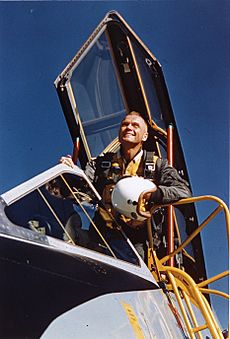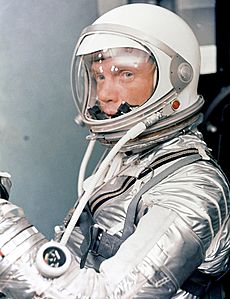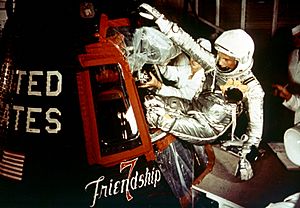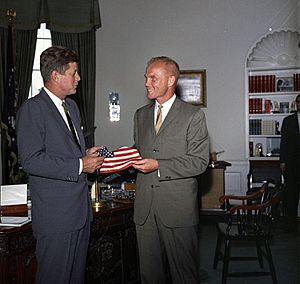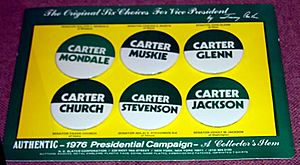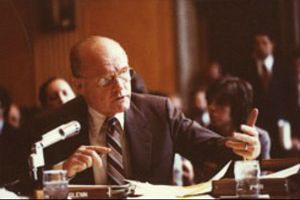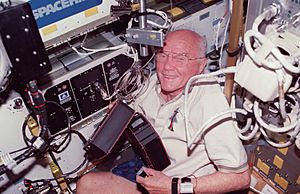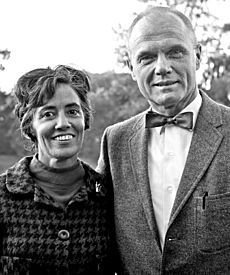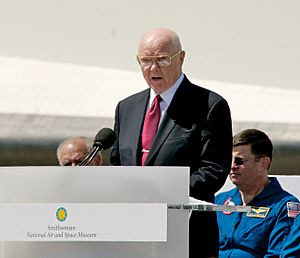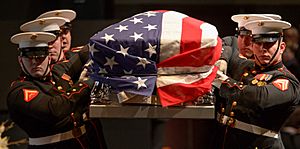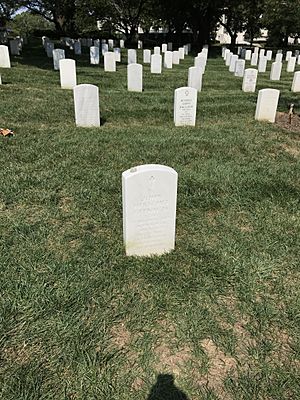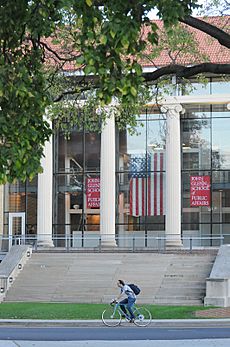John Glenn facts for kids
Quick facts for kids
John Glenn
|
|
|---|---|
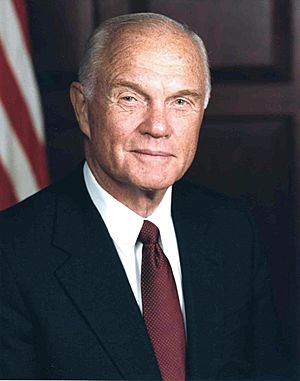 |
|
| Chair of the Senate Governmental Affairs Committee | |
| In office January 3, 1987 – January 3, 1995 |
|
| Preceded by | William Roth |
| Succeeded by | William Roth |
| United States Senator from Ohio |
|
| In office December 24, 1974 – January 3, 1999 |
|
| Preceded by | Howard Metzenbaum |
| Succeeded by | George Voinovich |
| Personal details | |
| Born |
John Herschel Glenn Jr.
July 18, 1921 Cambridge, Ohio, U.S. |
| Died | December 8, 2016 (aged 95) Columbus, Ohio, U.S. |
| Resting place | Arlington National Cemetery 38°52′48″N 77°04′12″W / 38.880°N 77.070°W |
| Political party | Democratic |
| Spouse | |
| Children | 2 |
| Education | Muskingum College (BS) |
| Civilian awards |
|
| Signature | |
| Military service | |
| Branch/service | |
| Years of service | 1941–1965 |
| Rank | Colonel |
| Battles/wars |
|
| Military awards |
|
| Occupation |
|
| Space career | |
| NASA astronaut | |
|
Time in space
|
4h 55m 23s |
| Selection | 1959 NASA Group 1 |
| Missions | Mercury-Atlas 6 |
|
Mission insignia
|
 |
| Retirement | January 16, 1964 |
| Space career | |
| NASA payload specialist | |
|
Time in space
|
9d 19h 54m 2s |
| Missions | STS-95 |
|
Mission insignia
|
 |
John Herschel Glenn Jr. (July 18, 1921 – December 8, 2016) was an amazing American hero. He was a brave Marine Corps pilot, a smart engineer, and a famous astronaut. He also became a successful businessman and a Democratic politician.
John Glenn made history as the third American to go into space. He was also the very first American to orbit the Earth. He circled our planet three times in 1962. After leaving NASA, he served as a U.S. Senator for Ohio from 1974 to 1999. In 1998, at age 77, he flew into space again! This made him the oldest person ever to travel to space.
Before becoming an astronaut, Glenn was a skilled fighter pilot. He fought in World War II, the Chinese Civil War, and the Korean War. He shot down three enemy planes and earned many awards for his bravery. In 1957, he made the first supersonic flight across the United States. His camera on board took the first continuous, panoramic photo of the country.
He was one of the Mercury Seven, a group of military test pilots chosen by NASA in 1959. They were the nation's first astronauts. On February 20, 1962, Glenn flew the Friendship 7 mission. He became the first American to orbit Earth. He was the third American and fifth person in history to reach space. He received many honors, including the Presidential Medal of Freedom in 2012.
Glenn left NASA in January 1964. He was elected to the Senate in 1974 and served for 24 years. He retired in January 1999. At 77, Glenn flew on Space Shuttle Discovery's STS-95 mission. This made him the oldest person to orbit Earth. He was also the only person to fly in both the Mercury and Space Shuttle programs. John Glenn was the oldest and last surviving member of the Mercury Seven. He passed away at 95 on December 8, 2016.
Contents
Military Career
Fighting in World War II
When the United States entered World War II, John Glenn left college. He joined the U.S. Army Air Corps. But the Army didn't call him for duty. So, in March 1942, he joined the U.S. Navy as an aviation cadet.
Glenn learned to fly at different bases. He made his first solo flight in Kansas. He later transferred to the U.S. Marine Corps. In March 1943, he became a second lieutenant. He married Annie on April 6, 1943.
After more training, he flew transport planes. He wanted to fly fighter planes instead. He got his wish and joined a squadron flying the F4U Corsair. He was promoted to first lieutenant in October 1943. In January 1944, he went to Hawaii.
His squadron moved to the Marshall Islands in June 1944. He flew 57 combat missions there. He earned two Distinguished Flying Crosses and ten Air Medals. After his tour, he continued to serve in the Marines. He was promoted to captain in July 1945. He also served in North China after the war.
In 1948, Glenn became a flight instructor. He later attended the Amphibious Warfare School. He was promoted to major in July 1952. He received several medals for his service in World War II.
Fighting in the Korean War
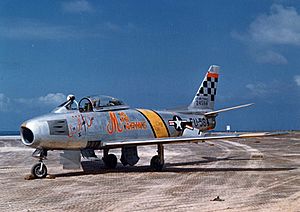
In October 1952, John Glenn went to South Korea during the Korean War. He first flew the F9F Panther jet fighter-bomber. He flew 63 combat missions with his squadron. He often flew low-level missions, and his plane sometimes came back with over 250 holes!
He even flew with Ted Williams, a famous baseball player. Williams later said Glenn was "Absolutely fearless. The best I ever saw."
In June 1953, Glenn started flying the faster F-86 Sabre jet. He patrolled an area called MiG Alley. Pilots hoped to fight MiG-15 planes there. Glenn wanted to be a "jet flying ace" by shooting down five enemy planes. His squadron mates called his plane "MiG Mad Marine."
He shot down his first MiG on July 12, 1953. He downed a second on July 19, and a third on July 22. These were the last air victories of the war. The war ended five days later. For his service in Korea, Glenn received two more Distinguished Flying Crosses and eight more Air Medals. He also earned several other medals for his time in Korea.
Becoming a Test Pilot
After his combat experience, Glenn wanted to become a test pilot. He joined the U.S. Naval Test Pilot School in Maryland in January 1954. He graduated in July. At the school, he learned from James Stockdale, who later won the Medal of Honor.
Glenn's first test flight, in an FJ-3 Fury, was very dangerous. The cockpit lost pressure, and the oxygen system failed. He also tested weapons on planes like the Vought F7U Cutlass and F8U Crusader.
On July 16, 1957, he made history. He completed the first supersonic transcontinental flight across the U.S. He called this flight Project Bullet. He flew an F8U Crusader jet from California to New York in 3 hours, 23 minutes. He flew faster than a .45 caliber bullet for most of the trip.
His camera on the plane took the first continuous, panoramic photo of the United States. He received his fifth Distinguished Flying Cross for this flight. He was promoted to lieutenant colonel in April 1959. This flight made Glenn a minor celebrity. He appeared in The New York Times and on a TV show. By age 36, he had almost 9,000 hours of flying time.
NASA Career
Becoming an Astronaut
On October 4, 1957, the Soviet Union launched Sputnik 1. This was the first artificial satellite. It made Americans worried about their technology. In response, President Dwight D. Eisenhower started the Space Race.
National Aeronautics and Space Administration (NASA) was created in October 1958. Its goal was to develop space technology. One of its first projects was Project Mercury. This project aimed to send a person into Earth orbit and bring them back safely.
Glenn was already interested in space. He had done tests for NASA on a spaceflight simulator. He also experienced high G-forces in a centrifuge. This made him an expert on space travel. He even started exercising to lose weight for the spacecraft.
President Eisenhower wanted NASA to choose its first astronauts from military test pilots. Glenn was a perfect candidate. He was almost 40 and didn't have a science degree. But he was an outstanding pilot and had taken many classes. His commanding officer even told NASA that Glenn would be the perfect astronaut.
Glenn impressed everyone during the selection process. He showed his centrifuge test results. He also stayed late to study spacecraft designs. On April 6, 1959, Glenn was chosen as one of the first seven astronauts. His wife, Annie, was supportive but worried about the danger. Many test pilots had died during his time at Patuxent.
The seven astronauts were announced on April 9, 1959. They were Scott Carpenter, Gordon Cooper, Glenn, Gus Grissom, Wally Schirra, Alan Shepard, and Deke Slayton. They were called the Mercury Seven. Author Tom Wolfe wrote that Glenn was the "tops" among them. He had the best pilot record and was very likable.
A few weeks later, the astronauts watched their first rocket launch. It was an SM-65D Atlas, similar to the one that would carry them into orbit. It exploded shortly after liftoff. The astronauts were shocked. Shepard joked, "Well, I'm glad they got that out of the way."
Glenn remained a Marine Corps officer. He helped design the cockpit layout for the Mercury and early Apollo programs. He also encouraged the other astronauts to be good role models.
The Friendship 7 Flight
Glenn was the backup pilot for the first two American space flights. These were sub-orbital missions. Then, Glenn was chosen for Mercury-Atlas 6. This was NASA's first mission to put a person in orbit. Scott Carpenter was his backup pilot.
Glenn named his spacecraft Friendship 7. He had the name painted on the side, just like his old F-86 jet. Glenn and Carpenter trained hard for the mission. Glenn spent many hours practicing in the spacecraft and simulator.
After many delays, Friendship 7 launched on February 20, 1962. It lifted off from Cape Canaveral Air Force Station. During the flight, the automatic control system failed. Glenn had to fly the spacecraft manually for two orbits and for re-entry.
Later, a sensor showed the heat shield might be loose. If true, Glenn's spacecraft would burn up during re-entry. Ground control told him to keep the retrorocket pack on. This might help hold the heat shield in place. Glenn was confused but followed the instructions.
During re-entry, flaming pieces flew past his window. Glenn thought it was the heat shield. But it was just the retrorocket pack breaking apart. Luckily, the heat shield was not loose; the sensor was faulty.
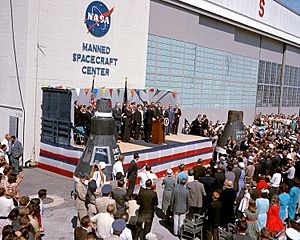
Friendship 7 landed safely in the ocean. Glenn's flight lasted 4 hours and 55 minutes. He traveled over 75,000 miles at about 17,500 miles per hour. The flight made Glenn the first American to orbit Earth. He was the third American and fifth human in space.
This mission boosted America's confidence during the Cold War. Glenn called it the "best day of his life." He became a national hero. He met President John F. Kennedy and had a huge parade in New York City. Kennedy didn't want to risk sending him to space again.
On February 23, 1962, President Kennedy gave Glenn the NASA Distinguished Service Medal. Glenn also received his sixth Distinguished Flying Cross. He was among the first astronauts to get the Congressional Space Medal of Honor in 1978.
Political Career
Running for Senate in 1964
At 42, Glenn was the oldest astronaut. He likely wouldn't fly to the Moon. So, he decided to enter politics. In December 1962, Attorney General Robert F. Kennedy suggested he run for the U.S. Senate in Ohio.
Glenn resigned from NASA on January 16, 1964. The next day, he announced his plan to run for the Senate. He was the first astronaut-politician. NASA quickly closed his office to avoid political bias.
In February, Glenn was hospitalized after a fall. He got a concussion and an inner-ear injury. This made him unable to campaign. His wife and Scott Carpenter campaigned for him. But doctors said he needed a year to recover. Glenn dropped out of the race on March 30.
He retired from the Marine Corps as a colonel on January 1, 1965. Later, he joined RC Cola as a vice president. He also bought hotels near Disney World. These businesses were very successful.
Running for Senate in 1970
Glenn stayed close to the Kennedy family. He campaigned for Robert F. Kennedy in 1968. He was with Kennedy when he won California. But Kennedy was assassinated shortly after. Glenn and Annie went to the hospital and later took Kennedy's children home. Glenn was a pallbearer at the funeral.
In 1970, a Senate seat in Ohio was open. Businessman Howard Metzenbaum ran against Glenn. Metzenbaum had more money and support from unions. Glenn lost the Democratic primary to Metzenbaum. Some people called Glenn a "hapless political rube."
After his defeat, Glenn remained active. Governor John J. Gilligan appointed him to lead a task force on environmental protection. This group helped create Ohio's Environmental Protection Agency.
Running for Senate in 1974
In 1973, a Senate seat became open again. Both Glenn and Metzenbaum wanted it. Governor John Gilligan offered Glenn the lieutenant governor position. This would avoid a tough primary fight. Glenn refused, calling it "bossism."
Metzenbaum was appointed to the Senate seat in January 1974. At the end of his term, Glenn challenged Metzenbaum again. Glenn's campaign changed its focus to larger counties.
In the primary, Metzenbaum criticized Glenn's lack of business experience. He said Glenn "never held a payroll." Glenn's famous reply became known as the "Gold Star Mothers" speech. He told Metzenbaum to look at veterans with injuries and tell them they didn't hold a job. He also said to tell a Gold Star mother her son didn't hold a job.
Glenn defeated Metzenbaum in the primary. He then won the general election against Ralph Perk. This began his long career in the Senate, which lasted until 1999.
Vice-Presidential Campaign in 1976
In the 1976 presidential election, Jimmy Carter was likely to be the Democratic nominee for president. Glenn was considered for vice president. He was a senator from an important state and was famous.
Some thought he was too similar to Carter. They also felt he didn't have enough experience to be president. Glenn gave a speech at the Democratic National Convention. But it didn't impress the delegates. Walter Cronkite called it "dull." Carter chose Walter Mondale instead. It was also reported that Carter's wife worried about Annie Glenn's stutter affecting the campaign.
Senate Reelection in 1980
In his first reelection campaign, Glenn ran mostly unopposed in the primary. His opponents were not well-known or funded. Glenn spent a lot of money on his campaign, even though he was likely to win. His team said he "takes nothing for granted." Glenn won the primary by a huge margin.
Jim Betts challenged Glenn for his seat. Betts criticized Glenn's policies and voting record. Glenn's campaign said his record was being taken "out of context." Glenn was expected to win easily. He won by the largest margin ever for an Ohio Senator.
Presidential Campaign in 1984
Glenn was worried about how divided the country was. He saw himself as a centrist. He believed a centrist president could unite the nation. He thought his experience as a senator from Ohio was ideal.
Glenn announced his candidacy for president on April 21, 1983. He started by raising more money than the front-runner, Mondale. He also polled highest against Reagan among Democrats.
In late 1983, the movie The Right Stuff was released. It was about the Mercury Seven astronauts. Ed Harris played Glenn as a hero. This helped Glenn's public image. But some thought the movie reminded people that his biggest achievement was decades ago. Glenn himself said the film "had a chilling effect on the campaign."
Glenn's campaign spent a lot on TV ads in Iowa. But he finished fifth in the Iowa caucus. He also lost in New Hampshire and on Super Tuesday. He withdrew from the race on March 16, 1984. He carried $3 million in campaign debt for over 20 years.
Senate Reelection in 1986
Glenn's Senate seat was challenged by Thomas Kindness. Glenn won his primary easily. Kindness focused on Glenn's campaign debts from his presidential run. He pointed out that Glenn stopped payments on the debt while campaigning for the Senate.
Glenn won the race with 62% of the vote. He joked, "We proved that in 1986, they couldn't kill Glenn with Kindness."
Senate Reelection in 1992
In 1992, Republican Mike DeWine challenged Glenn. DeWine focused on the need for change and term limits. This would be Glenn's fourth term as senator. DeWine also criticized Glenn's campaign debts. He used an ad with a bunny saying, "He just keeps owing and owing and owing."
During a debate, Glenn asked DeWine to stop the negative ads. DeWine replied that he would if Glenn explained money he received from Charles Keating. This was part of the Keating Five scandal. Glenn won the Senate seat. It was DeWine's first campaign loss.
Senate Career
Working on Committees
When Glenn became a senator, he wanted to join two committees. These were the Governmental Affairs Committee and the Foreign Relations Committee. He was assigned to Governmental Affairs right away.
In 1977, Glenn became chairman of a subcommittee. It focused on energy, nuclear safety, and federal services. He also took charge of the U.S. Postal Service subcommittee. Previous chairmen had lost elections because of problems with mail service. But Glenn accepted the challenge.
One of his main goals was to create environmental policies. He introduced bills to deal with the energy crisis. He also wrote laws to prevent the spread of nuclear weapons. He was the main author of the Nuclear Non-Proliferation Act of 1978. This was the first of six major laws he created on this topic.
Glenn chaired the Governmental Affairs Committee from 1987 to 1995. He found safety and environmental problems at the nation's nuclear weapons sites. He asked for investigations and held hearings. He also released a report on the huge costs of cleaning up nuclear waste. He spent the rest of his Senate career getting money to clean up these sites.
Glenn also worked to reduce government waste. He created laws to require CFOs (Chief Financial Officers) for large government agencies. He also wrote a bill to add inspector general offices to federal agencies. These offices help find waste and fraud. He also founded the Great Lakes Task Force to protect the environment of the Great Lakes.
In 1995, Glenn became the top Democrat on the Governmental Affairs Committee. He disagreed with the focus on illegal Chinese donations to Democrats. He believed Republicans also had fundraising issues. The committee chairman, Fred Thompson, continued the investigation. Glenn felt Thompson was not fair. The investigation ended with a report written by Republicans. Glenn and other Democrats said the report did not prove that the "China plan" affected the 1996 presidential election.
Glenn was also the vice chairman of the Permanent Subcommittee on Investigations. This subcommittee investigated issues like Internet fraud and mortgage fraud.
Other Senate Work
Glenn's father and father-in-law had expensive medical treatments. This motivated him to join the Special Committee on Aging.
Glenn was known as an expert in science and technology. He supported the B-1 bomber program. But he disagreed with President Carter's plan to fund the B-2 bomber. Glenn doubted the stealth technology would work. He tried to slow down the B-2's development to save money, but his idea was rejected.
Glenn joined the Foreign Relations Committee in 1978. He became chairman of the East Asian and Pacific Affairs Subcommittee. He traveled to Japan, Korea, and China. He helped pass the Taiwan Enabling Act in 1979.
In the same year, Glenn disagreed with President Carter again. This was about the SALT II treaty. Glenn believed the U.S. couldn't accurately monitor the Soviet Union. He spoke publicly about his doubts. First Lady Rosalynn Carter criticized him for this. The Senate never approved the treaty.
Glenn served on the Foreign Relations Committee until 1985. He then joined the Armed Services Committee. He became chairman of the Manpower Subcommittee in 1987. He helped pass laws to increase pay and benefits for American troops during the Gulf War.
Keating Five Scandal
Glenn was one of the Keating Five. These were U.S. Senators involved in a savings and loan scandal. Glenn had accepted a $200,000 campaign donation. The senators were accused of delaying the seizure of a bank, which cost taxpayers a lot of money.
The Senate Ethics Committee investigated. Glenn and another senator were found to have used "poor judgment." Republicans focused on Glenn's "poor judgment." Glenn said he did nothing wrong. He wrote in his autobiography that these hearings were a very low point in his life. The case cost him $520,000 in legal fees. Despite this, he won his 1992 reelection campaign.
Retirement from the Senate
On February 20, 1997, Glenn announced he would retire from the Senate. This was the 35th anniversary of his Friendship 7 flight. He retired because of his age. He said, "... There is still no cure for the common birthday." His term ended in January 1999.
Return to Space
After the Space Shuttle Challenger disaster in 1986, Glenn said it was wrong to send regular people to space. He thought only research scientists should fly. In 1995, Glenn read a book about space physiology. He realized that changes in space, like bone loss, are similar to aging.
Glenn thought NASA should send an older person to space. He believed it should be him. Starting in 1995, he asked NASA director Dan Goldin for the mission. Goldin said he would consider it if there was a scientific reason. Glenn also had to pass the same physical tests as younger astronauts. Glenn did research and passed the physical.
On January 16, 1998, NASA announced Glenn would join the STS-95 crew. At 77, he became the oldest person to fly in space. NASA and the National Institute of Aging used Glenn for research. They compared his health data with younger crew members. He also took photos and videos.
Glenn returned to space on October 29, 1998. He was a payload specialist on Space Shuttle Discovery. President Bill Clinton sent him a congratulatory email. This is often called the first email from a sitting U.S. president.
Some people criticized his participation. They thought it was a favor from Clinton. John Pike of the Federation of American Scientists said it had "nothing to do with medicine."
In 2012, Glenn said he wished NASA had continued research on aging. He wanted more elderly people to go to space. After STS-95 returned, the crew had a parade. Glenn received the NASA Space Flight Medal. In 2001, Glenn opposed sending Dennis Tito, the first space tourist, to the International Space Station. He felt Tito's trip had no scientific purpose.
Personal Life
John and Annie Glenn had two children, John David and Carolyn Ann. They also had two grandchildren. They were married for 73 years until John's death.
Glenn was a Freemason. He became a member of Concord Lodge No. 688 in Ohio in 1978. In 1999, he became a 33rd-degree Scottish Rite Mason. He was also honored by DeMolay International, a Masonic youth group.
Glenn was an elder in the Presbyterian Church. His faith grew stronger after traveling in space. He said, "To look out at this kind of creation and not believe in God is to me impossible." He believed in both God and evolution. He thought evolution should be taught in schools.
Public Appearances
Glenn was an honorary member of the International Academy of Astronautics. He was also a member of many other groups. These included the Society of Experimental Test Pilots and the National Space Club. In 2001, he appeared as himself on the TV show Frasier.
On September 5, 2009, John and Annie Glenn took part in a special tradition. They dotted the "i" in Ohio State University's Script Ohio marching band performance. This honor is usually for veteran band members.
On February 20, 2012, Glenn celebrated the 50th anniversary of his Friendship 7 flight. He had a surprise chance to talk with the crew of the International Space Station. On April 19, 2012, Glenn helped transfer the Space Shuttle Discovery to the Smithsonian Institution. He used the chance to criticize the end of the Space Shuttle program. He felt it delayed important research.
Illness and Death
Glenn was healthy for most of his life. He kept his private pilot's license until he was 90. In June 2014, he had successful heart surgery. In early December 2016, he was hospitalized in Columbus, Ohio. His health was declining. His family was with him.
John Glenn died on December 8, 2016, at age 95. The cause of death was not shared. His body lay in state at the Ohio Statehouse. Memorial services were held at Ohio State University and Kennedy Space Center. He was buried at Arlington National Cemetery on April 6, 2017. At the time of his death, Glenn was the last surviving member of the Mercury Seven.
President Barack Obama said Glenn "reminded us that with courage and a spirit of discovery there's no limit to the heights we can reach together." Many others, including Vice President Joe Biden and President-elect Donald Trump, also paid tribute.
The phrase "Godspeed, John Glenn" became a popular social media hashtag. This was what fellow astronaut Scott Carpenter said when Glenn launched into space. President Obama ordered flags to be flown at half-staff until Glenn's burial.
Awards and Honors
John Glenn received many awards and honors throughout his life. He was given the John J. Montgomery Award in 1963. He also received the National Geographic Society's Hubbard Medal in 1962. In 2006, he and 37 other astronauts received the Ambassador of Space Exploration Award.
He earned the Navy's astronaut wings and the Marine Corps' Astronaut Medal. In 2011, he was awarded the Congressional Gold Medal. In 2012, President Barack Obama presented Glenn with the Presidential Medal of Freedom. These two awards are the highest honors for a civilian.
Glenn was inducted into several halls of fame. These include the International Air & Space Hall of Fame in 1968 and the U.S. Astronaut Hall of Fame in 1990. In 2000, he received a Jefferson Award for public service.
In 1961, Muskingum University gave Glenn an honorary degree. He also received honorary doctorates from other universities. In 1998, he helped create the John Glenn Institute at Ohio State University. This institute encouraged public service. It later became the John Glenn College of Public Affairs.
Many places and things are named after him. The Glenn Research Center in Cleveland is named for him. A highway in Ohio is called the Senator John Glenn Highway. Colonel Glenn Highway in Ohio and Arkansas is also named after him. Several high schools across the country bear his name.
The fireboat John H. Glenn Jr. in Washington, D.C., is named for him. So is the ship USNS John Glenn (T-MLP-2) for the U.S. Navy. In June 2016, the Columbus, Ohio, airport was renamed John Glenn Columbus International Airport. Glenn attended the ceremony. He spoke about how visiting the airport as a child sparked his interest in flying. In September 2016, Blue Origin named their new rocket the New Glenn. Orbital ATK named a space capsule "S.S. John Glenn" in his honor. It successfully launched in April 2017.
 |
|||
| Naval Aviator Astronaut Insignia | ||
| Distinguished Flying Cross with three gold stars and one bronze cluster |
||
| Air Medal with one silver and 2 gold stars and two silver clusters |
Navy Presidential Unit Citation | Navy Unit Commendation |
| Presidential Medal of Freedom | Congressional Space Medal of Honor | NASA Distinguished Service Medal |
| NASA Space Flight Medal with one oak leaf cluster |
Marine Corps Expeditionary Medal | China Service Medal |
| American Campaign Medal | Asiatic-Pacific Campaign Medal with one star |
World War II Victory Medal |
| Navy Occupation Service Medal with "ASIA" clasp |
National Defense Service Medal with one star |
Korean Service Medal with two campaign stars |
| Presidential Unit Citation (Korea) | United Nations Korea Medal | Korean War Service Medal |
Legacy
John Glenn's public life and legacy began when he broke the transcontinental airspeed record. As a senator, he used his military background to write laws. These laws aimed to reduce the spread of nuclear weapons. He also worked to reduce government waste.
Buzz Aldrin wrote that Glenn's Friendship 7 flight helped inspire the country. It encouraged America to overcome the challenges of human spaceflight.
President Barack Obama said, "With John's passing, our nation has lost an icon. John spent his life breaking barriers. He defended our freedom as a Marine Corps pilot. He set a speed record. And at age 77, he became the oldest human to touch the stars." Obama ordered the U.S. flag to be flown at half-staff in Glenn's memory. NASA administrator Charles Bolden said, "Senator Glenn's legacy is one of risk and accomplishment. It is about history created and duty to country carried out under great pressure."
See also
 In Spanish: John Glenn para niños
In Spanish: John Glenn para niños


